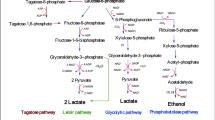Abstract
A cellulase-producing bacterial strain designated Z5 was isolated from the fecal matter of Zebra (Equus zebra). The strain was identified as Microbacterium sp. on the basis of 16S rDNA sequence analysis. The effect of substrates like CMC, avicel, starch, maltose, sucrose, glucose, fructose, galactose, and lactose on cellulase production was also determined. Lactose as the sole carbon source induced cellulase production in this bacterial strain and a positive synergistic effect of lactose and CMC was also observed with enhancement of 3–4 times in cellulase activity. The optimum cellulase production was recorded with 3% CMC and 1% lactose when added individually in the Omeliansky’s medium. The optimum temperature and time for cellulase production by this bacterial strain was 37°C and 10 days, respectively. To our knowledge this is the first report on enhancement of cellulase production by lactose in the Microbacterium sp.




Similar content being viewed by others
References
Baker W, Panow A (1991) Estimation of cellulase activity using glucose-oxidase-Cu (II) reducing assay for glucose. J Biochem Biophys Methods 23:265–271
Carle-Urioste JC, Escobar-Vera J, EI-Gogary S, Henrique-Silva F, Torigoi E, Crivellaro O, Herrera-Estrella A, EI-Dorry H (1997) Cellulase induction in Trichoderma reesei by cellulose requires its own basal expression. J Biol Chem 272:10169–10174
Cherry JR, Fidanstef AL (2003) Directed evolution of industrial enzymes: an update. Curr Opin Biotechnol 14:438–443
Costa RB, Silva MVA, Freitas FC, Leitão VSF, Lacerda PSB, Ferrara MA, Bon EPS (2008) Mercado e Perspectivas de Uso de Enzimas Industriais e Especiais no Brasil. In: Bon EPS, Ferrara MA, Corvo ML, Vermelho AB, Paiva CLA, Alencastro RB, Coelho RRR (org) Enzimas em Biotecnologia, Produção, Aplicações e Mercados, 1st edn. Interciência, Rio de Janeiro, pp 463–488
George SP, Ahmed A, Rao MB (2001) Studies on carboxymethyl cellulase produced by an alkalothermophilic actinomycete. Bioresour Technol 77:171–175
Ghosh TK (1987) Measurement of cellulase activities. Pure Appl Chem 59:257–268
Harchand RK, Singh S (1997) Characterization of cellulase complex of Streptomyces albaduncus. J Basic Microbiol 37(2):93–103
Ilmen M, Saloheimo A, Onnela ML, Penttila ME (1997) Regulation of cellulase gene expression in the filamentous fungus Trichoderma reesei. Appl Environ Microbiol 63:1296–1306
Jukes TH, Cantor CR (1969) Evolution of protein molecules. In: Munro HN (ed) Mmmalian Protein Metabolism, vol 3. Academic Press, New York, pp 21–132
Karaffa L, Fekete E, Gamauf C, Szentirmai A, Kubicek CP, Seiboth B (2006) Dgalactose induces cellulase gene expression in Hypocrea jecorina at low growth rates. Microbiology 152:1507–1514
Kinnear PR, Gray CD (2000) SPSS for Windows made simple. Release10. Psychology Press, Sussex
Kluepfel D, Shareck F, Mondau F, Morosoli R (1986) Characterization of cellulase and xylanase activities of Streptomyces lividans. Appl Microbiol Biotechnol 24:230–234
Lowry OH, Rosebrough NJ, Farr AL, Randall RJ (1951) Protein measurement with the folin-phenol reagent. J Biol Chem 193:265–275
Miller GL (1959) Use of dinitrosalicylic acid reagent for determination of reducing sugars. J Analyt Chem 31:426–428
Miranda M, Kam Tin L, Wensheng Q (2009) The prospects of cellulase-producing bacteria for the bioconversion of lignocellulosic biomass. Int J Biol Sci 5(5):500–516
Moreira AR, Philips JA, Humphrey AE (1981) Production of cellulases by Thermomonospora sp. Biotechnol Bioeng 23:1339–1347
Omeliansky W (1902) Ueber die Garung der cellulose. Centrabl Bakt II Abt 8:225–231
Pandey KK, Mayilraj S, Chakrabarti T (2002) Pseudomonas indica sp. nov., a novel butane utilizing species. Int J Syst Evol Microbiol 52:1559–1567
Saitou N, Nei M (1987) The neighbor-joining method: a new method for reconstructing phylogenetic trees. Mol Biol Evol 4:406–425
Schrempf H, Walter S (1995) The cellulolytic system of Streptomyces reticuli. Int J Biol Macromol 17(6):353–355
Seiboth B, Hofmann G, Kubicek CP (2002) Lactose metabolism and cellulase production in Hypocrea jecorina: the gal 7 gene, encoding galactose-1-phosphate uridylyltransferase, is essential for growth on galactose but not for cellulase induction. Mol Genet Genomics 267:124–132
Semedo LT, Gomes RC, Bon EP, Soares RM, Linhares LF, Coelho RR (2000) Endocellulase and exocellulase activities of two Streptomyces strains isolated from a forest soil. Appl Biochem Biotechnol 84:267–276
Shivaji S, Rao NS, Saisree L, Reddy GSN, Seshu Kumar G, Bhargava PM (1989) Isolates of Arthobacter from the soils of Schirmacher Oasis, Antarctica. Polar Biol 10:225–229
Stackebrandt E, Goebel B (1994) Taxonomic note: a place for DNA-DNA reassociation and 16S rRNA sequence analysis in the present species definition in bacteriology. Int J Syst Bacteriol 44:846–849
Stewart CS, Funt HJ, Bryant MP (1997) The rumen microbial ecosystem. Blackie Academic and Professional publishers, London
Suresh K, Mayilraj S, Chakrabarti T (2006) Effluviibacter roseus gen. nov. sp. nov., isolated from muddy water, belonging to the family ‘Flexibacteraceae. Int J Syst Evol Microbiol 56:1703–1707
Suto M, Tomita F (2001) Induction and catabolite repression mechanisms of cellulase in fungi. J Biosci Bioeng 92:305–311
Teather RM, Wood PJ (1982) Use of Congo red–polysaccharide interactions in enumeration and characterization of cellulolytic bacteria from the bovine rumen. Appl Environ Microbiol 43:777–780
Thompson JD, Gibson TJ, Plewniak F, Jeanmougin F, Higgins DG (1997) The CLUSTAL_X windows interface: flexible strategies for multiple sequence alignment aided by quality analysis tools. Nucleic Acids Res 25(24):4876–4882
Tuncer M, Kuru A, Isikli M, Sahin N, Celenk FG (2004) Optimization of extracellular endoxylanase, endoglucanase and peroxidase production by Streptomyces sp F2621 isolated in 17.Turkey. J Appl Microbiol 97(4):783–791
Van de Peer Y, Wachter RD (1997) Construction of evolutionary distance trees with TREECON for Windows: accounting for variation in nucleotide substitution rate among sites. Comput Appl Biosci 13:227–230
Zar JH (1999) Biostatistical analysis, 4th edn. Pearson education (Singapore) Pvt. Ltd, New Delhi, p 663
Acknowledgment
Financial support for the first author provided by University Grant Commission through Burdwan University is acknowledged.
Author information
Authors and Affiliations
Corresponding author
Rights and permissions
About this article
Cite this article
Sadhu, S., Saha, P., Mayilraj, S. et al. Lactose-Enhanced Cellulase Production by Microbacterium sp. Isolated from Fecal Matter of Zebra (Equus zebra). Curr Microbiol 62, 1050–1055 (2011). https://doi.org/10.1007/s00284-010-9816-x
Received:
Accepted:
Published:
Issue Date:
DOI: https://doi.org/10.1007/s00284-010-9816-x




